#perhaps i will
Explore tagged Tumblr posts
Text
puff puff pass shoko

#want to post for sukuna outside of sjap so bad#so tempted to open my requests again#perhaps i will#tmr…. question mark#gn post
86 notes
·
View notes
Text
What if I made Siffrin a Yo-Kai
Would that be fucked up or what
#in stars and time#isat#in stars and time siffrin#isat siffrin#yo kai watch#ykw#yokai watch#yo-kai Watch#perhaps i will#psi-post
26 notes
·
View notes
Text
Having Thoughts and Feelings about my husband right now. Perhaps I should act on them.
9 notes
·
View notes
Text
should i go to ireland only to spend two days on top of a mountain in the middle of nowhere sleeping in some lady‘s living room?
16 notes
·
View notes
Text
YET ANOTHER BROTHERSHIP BOZO COSPLAY UPDATE WOOOOOO !!!!!!!!!!!!
alright so, i have made QUITE A LOT OF PROGRESS and this dummy is looking quite good [yes i will continue to put spoiler warnings on these posts even though the game has been out for 4 months already]


WIRES ATTATCHED !!!!!!!! now all he needs are his extra hands, glohm wire tips, and a paint job to clean up all the pencil lines all over him
i do need to find a way to stabilize him though, due to the weight of the wires i need to keep him upright via the neck somehow At this pace, the rebirth will be complete much sooner than what was estimated. [byyyyy the wayyy, i'll be making a plushy of my beloved seedlusa too since i have a lot of fabric left :3]
#cosplay#man i am posting a LOT of these updates aren't i?#mario and luigi brothership#weeehgehehehehehehduwhegfh#ougfh this is a pain to wear but its so funnnnnnnn#once i'm finished with this i'll either work on an outfit or just straight up the in-game clothes for funnies#yeah#perhaps i will#fun fact: i was up till like 4 am working on this cretin!!!!#somehow i was not tired after waking up at 7 am :D#anyways time to tag his name now because this is a required thing due to spoilerssss#mario and luigi brothership reclusa#reclusa#he is the silliest boi in brothership fr fr
12 notes
·
View notes
Text
SUPPORTIVE mlm - bi woman hostility
33 notes
·
View notes
Note
Ngl, even without all of your beautifully detailed pictures; though even with one picture I still could "see" what you were throwing down in "The Lady & The Upstairs Neighbor" storyline. Feel free to continue on...
👀👀👀👀👀👀👀👀
11 notes
·
View notes
Text

"with your foreseeing eyes, what do you see? until you open it, you cannot know, afraid to see what's on the other side. oh, can't you see, i feel the same as you?"
#mementosart#sourceart#sources and systems#an unreality based on final fantasy#χnoblade: neo america edition#sys: mira#did they name it after you or were you named for it?#you will recall our names... well#perhaps i will#i will know your name#i will to know it.
4 notes
·
View notes
Text
Hello there, I am a space nerd, a fact I’m sure no one guessed from the fact that I go by Stars on the internet. I am here to explain how the moon works, because I think it’s cool and also something that most people don't know. This is mostly an infodump just for fun, but may also be vaguely useful for artists, writers & stargazers.
By “how the moon works,” I mean that although pretty much everyone knows about the moon’s phases, not everyone really gets how they affect things like when & where the moon is in the sky. See: the common idea that the sun is in the sky in the day, and the moon is in the sky at night. You know this isn’t strictly true if you’ve ever seen the moon in the sky in the daytime, but do you know how it actually works? If I gave you a moon phase and a time of day, would you be able to tell me whether the moon was in the sky or not?
I am here to (hopefully) explain how you can do that! With scribbly diagrams! Please join me under the readmore if you would like to come to my TED talk.
First of all, to avoid any accidental curse-of-knowledge assumptions on my part, let me define some terms!
First off, the phases of the moon, which you probably know most of, but bear with me. A “full moon” is when the moon is fully illuminated and appears as a circle in the sky. A “gibbous moon” is when the moon is more than half full, but not completely full—it appears large and roundish, but not a circle (not everyone knows the name for this one). A “half moon” is when the moon is half illuminated and appears as a semicircle—this one has some other names that I’ll get to in a second. A “crescent moon” is when the moon is less than half illuminated and appears as a concave curve. A “new moon” is when the moon is completely dark from Earth’s perspective and can’t be seen in the sky.

Also, “waxing” is when the moon is transitioning from new to full, or getting bigger in the sky, and “waning” is when the moon is transitioning from full to new, or getting smaller in the sky.
Speaking of “half moon,” I frequently confuse friends by calling this a “first quarter” or a “third quarter” moon. Those names refer not to the illumination of the moon but to the full cycle of phases. If you think of the moon phases as split into four quarters, starting from zero at a new moon, then halfway to full is 1/4, full is 1/2, halfway back to new is 3/4, and then we’ve reached the end/beginning of the cycle with another new moon. So one of the half moons is a first quarter moon, and the other (with the other half illuminated) is a third quarter moon.
This is where I have to add a disclaimer—I am in the northern hemisphere, and I am familiar with astronomy in the northern hemisphere. If you are in the southern hemisphere, to you, I am looking at the moon “upside down.” Yes, really. If you’re using my diagrams, flip them upside down. I’ll try to be clear when I’m talking about stuff that flips between the hemispheres, but it’s something that I struggle to wrap my head around too, so apologies if I’m confusing or miss something.
So, here’s a diagram of the moon phases to show you the difference between first and third quarter moons, but if you’re in the southern hemisphere, please flip it over to see what they would look like for you. (The chronological order still goes in the same direction as the arrow, the moon itself is just the other way in the sky.)
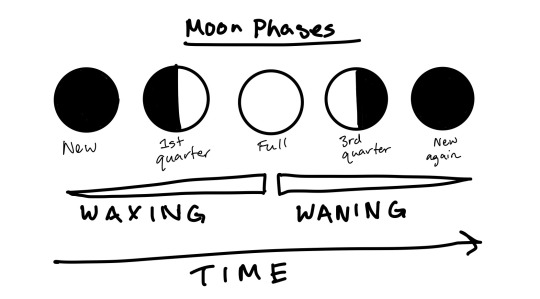
The fun trick I was taught to remember which way the cycle goes is “light from the right.” (Southern hemisphere people, you’ll have to flip this one.) Light, or shadow, moves from the right edge of the moon to the left. So if the moon is a crescent and the right edge is lit up, it’s waxing, or moving towards full. If the moon is a gibbous with a dark right edge, it’s just past full and will be waning towards the third quarter over the next few days. If you look at the diagram above (and imagine the crescent and gibbous phases transitioning in between), this might be easier to imagine.
Like I said, for the southern hemisphere this would actually be “light from the left.” If you’re near the equator and the moon is overhead, you could use “light from the west,” because that’s secretly the real rule. Another thing that’s useful to know for stargazing—the moon, sun and planets follow a path in the sky called the ecliptic, which is roughly over the equator. (Not exactly—it wiggles around relative to earth’s surface, because of the tilt of the earth’s axis that causes the seasons, but it stays near the equator.) If you’re standing in the northern hemisphere, the equator is south of you, so the ecliptic is also in the southern part of the sky. When you look at the moon, it will always be in the south, so the west-facing side of the moon will always be to your right. Likewise, if you’re in the southern hemisphere, the moon (and sun, and planets) will always appear in the northern half of the sky, so west will be to your left. Light moves across the moon’s surface from the west to the east.
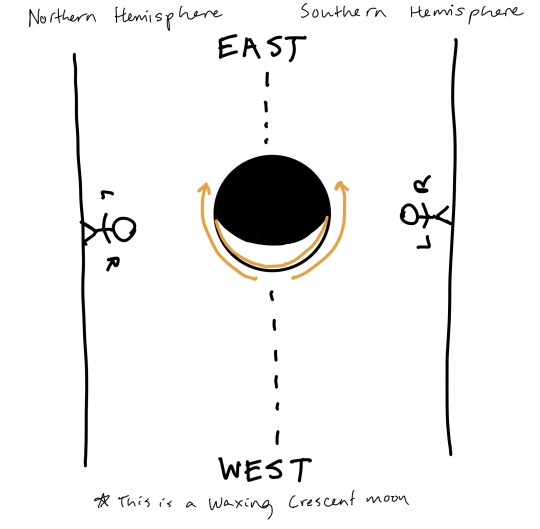
Now you can impress people by looking at the moon and saying, “Oh look, what a lovely waxing gibbous!” (I don’t actually know if the is impressive, but I do it all the time. For bonus points, get an app on your phone that tells you the phase of the moon and check it frequently so you can plan when to stargaze. Then you can casually mention that the moon will be full in a couple days when it’s not even in the sky, and maybe people will think you’re a werewolf.)
Now that I’ve explained the moon’s phases, I get to explain how they’re related to the time and place that the moon is in the sky. See, most people (I assume) don’t think twice about things like, say, a book describing a crescent moon in the sky overhead at midnight. But that actually can’t happen! And it has to do with the moon’s position in the 3D solar system, and how that maps onto our sky. This is kind of hard for me to explain without a lot of 3D hand gestures and pointing at the sky, but I’m gonna do my best to show it in two dimensions.
So, most people probably know that the moon’s phases are caused by the sun’s light illuminating half of the moon, and since the relative positions of the moon, sun & earth change throughout the month, the half that’s illuminated moves around the moon and changes how it looks from our viewpoint. So, a very basic rule: the side of the moon that’s illuminated is the side that’s facing the sun.
So, when the moon is full, that’s because the side that faces us is also facing the sun. This means the sun is directly opposite the moon. Here’s a very scientific diagram:
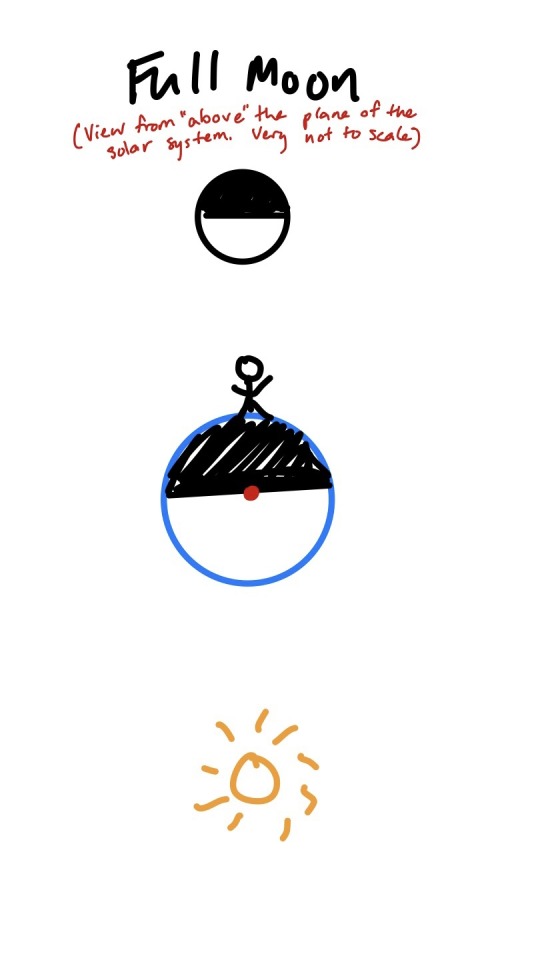
In case it’s not clear, this is a “top-down” view of the solar system where the moon, earth and sun are all in the same plane (in this case it doesn’t matter if we’re looking at the north or south pole, the positions would look the same). It’s also obviously not to scale and very simplified, but the point is to demonstrate that the moon is opposite the earth from the sun.*
The little person on the earth is of course spinning around as the earth rotates once per day. But at this point in the lunar month, you can see that when they are on the side of the earth where they can see the moon, they are also on the side facing away from the sun. When the moon is full or close to full, it’s opposite the sun—it rises around sunset, sets around sunrise, and is at its peak in the sky around midnight. This is how lots of people tend to think of the moon rising and setting, but it’s only true when the moon is close to full!
If that doesn’t make sense, here’s a diagram of when the moon is at the opposite point in its cycle, a new moon:
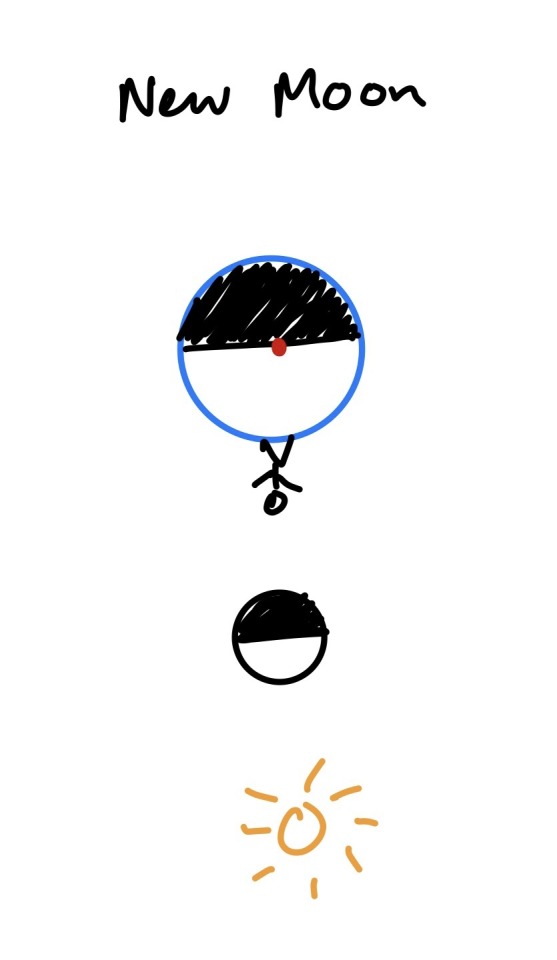
When the moon is new, the side that faces the earth is dark, which means the opposite side is facing the sun. The moon is on the same side of earth as the sun is. The little person spinning around the earth won’t see the moon in the night sky, because the moon is close to the sun in the sky,* and it’s actually rising in the morning and setting in the evening at this time of the month! You can’t easily see the moon when it’s new, but it might be visible a few days before or after this as a crescent. You’ll only see a crescent moon in the sky during the day, or close to dawn/dusk—it will be close above the horizon where the sun has just set or is about to rise. (The light edge faces the sun, so if it’s near the horizon in twilight sometimes it will look like the light edge is actually pointing down, with the tips of the crescent pointing up in the sky.)
*A side note on eclipses: My diagram is oversimplified! The moon, earth and sun aren’t actually all in the same plane all the time, they’re slightly misaligned. So even when I say the moon and sun are “directly” opposite each other, or aligned, they aren’t lined up perfectly enough to cast shadows on each other most of the time. When they do line up perfectly at the right time, that’s when you get a solar eclipse (when the moon is new) or lunar eclipse (when the moon is full).
Okay, so when the moon is full it’s in the sky at night, and when the moon is new it’s in the sky during the day. What about in between? This is where it gets a little confusing, especially for those of you in the southern hemisphere, who are going to have to flip everything I say. Apologies in advance, but it kind of hurts my head even to explain how this works in my own half of the sky.
So, when the moon is half-full, at the first quarter and third quarter of the phase cycle I explained above, the sun’s light is coming (from our perspective) from the side. The moon is ninety degrees away in its orbit from full or new, and the sun’s light is effectively perpendicular to our viewpoint, instead of parallel. This time it matters which way we’re looking, so these are a top-down view from the northern-hemisphere side. If you’re in the southern hemisphere, I think you can flip which is the first & third quarter to make this accurate.
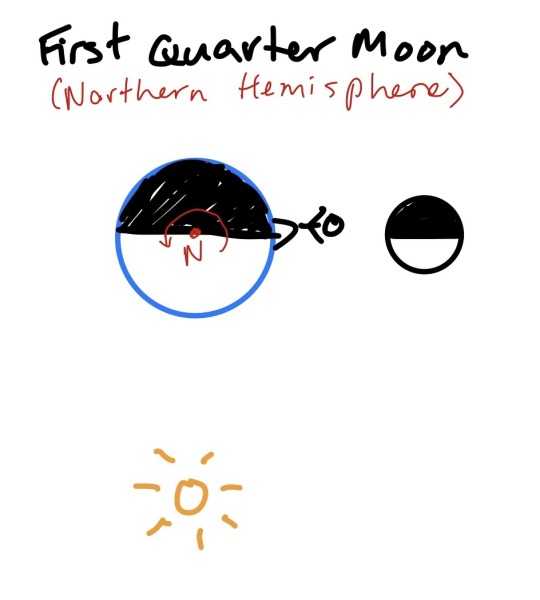
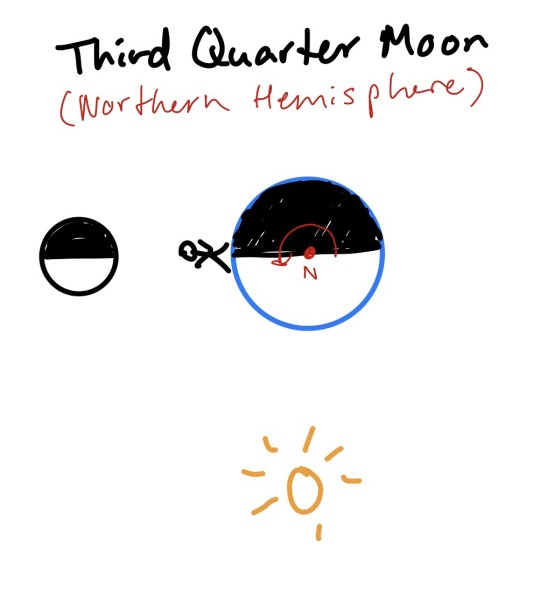
As you can see, when our little person is spinning around the globe, they’re going to be seeing the moon high in the sky right around the line between night and day. From a northern perspective, the earth spins counter-clockwise (vice versa from the south), so if you picture the person spinning around their little earth, you can see that the first quarter moon is going to be visible when they’re spinning from light to dark (sunset) and the third quarter moon is going to be visible when they’re spinning from dark to light (sunrise).
Bonus fun trick: If you remember the rule of “light from the right” in the northern hemisphere and how that determines the order of the phases, and look at these diagrams again, you can figure out which direction the moon orbits the earth from this viewpoint. (This is, in fact, the only way I can remember which direction the moon orbits the earth, despite being far more complicated than just memorizing it. If you’d like to make a game of it, I’ll put the answer at the bottom of the post).
Remembering how this looks from this top-down floating-above-the-earth perspective is hard, but you don’t really have to. I only explained it so it would make sense when I went back to my earlier visualization, from when I was explaining how “light from the right” works. I’m a very spatial learner, and I like picturing things relative to my own body, so this is how I remember when the different phases of the moon appear in the sky:
Imagine you’re standing, facing the ecliptic, where the sun and the moon travel through the sky. In the northern hemisphere, you’re facing south, with east to your left and west to your right. Imagine that the sun has just set, falling beneath the horizon to your right. Imagine that the moon is full, and hopefully I’ve explained well enough that now you know where it will be—cresting the horizon at your left. Imagine the opposite too—the sun is rising in the east at your left, as the full moon sinks in the west at your right. The new moon’s position, if you’d like to visualize that, is effectively the same as the sun.
Now, the difference between the two half-moons. Light comes from the west—in the northern hemisphere, your right—so when the right half is illuminated, it’s the first quarter of the lunar month, waxing to full, and when the left half is illuminated, it’s the third quarter, waning to new. One is high at dusk and one is high at dawn. Which is which?
You’re facing south. Picture a first quarter moon, right side lit up, at its peak in the southern sky. The light side is always facing the sun. Where is the sun? It must be to your right, touching the horizon in the west, setting. The first quarter moon is in the sky before, during and after dusk.
Picture a third quarter moon, left side lit up, at its peak. The light side faces the sun. The sun is to your left, touching the horizon in the east, rising. The third quarter moon is in the sky before, during and after dawn.
When I imagine this, I’m standing on my back porch, where I often go outside and stargaze. My telescope is small and one of the few things it can see with any detail is the moon. I want to be able to look at the moon just after dark, without having to stay up too late—and this memory device, of facing south and imagining the sun at my right hand to the west, is how I remember that the first quarter is the best time for me to observe the moon. It will be high in the sky at sunset, easy for me to see over the houses and trees.
If you remember that the moon waxes and wanes from the west (right in the north, left in the south), then you can fill in all the gradations of crescent and gibbous moon between the four main quarters. (As an example, if I wait a few days past first quarter to go outside and look at the moon, it’s waxed into a gibbous moon and it rises later in the evening, peaking in the sky closer to midnight. Another example: a waxing crescent is between a new moon and first quarter, so it will trail behind the sun and be above the horizon in the southwest at sunset.)
I hope that all of this makes sense and is useful to someone, whether for figuring out when you can observe the moon and where in the sky to look, or for thinking about how to place it in the sky in your writing and art. If nothing else, I hope I have brought you entertainment, and/or ruined the way the moon works in Minecraft for you forever. (It rises and sets directly opposite the sun!! Even when it’s a new moon!!! Light doesn’t work like that!!)
And finally, if you were trying to guess, the moon orbits the earth counter-clockwise if you’re looking down from the northern side.
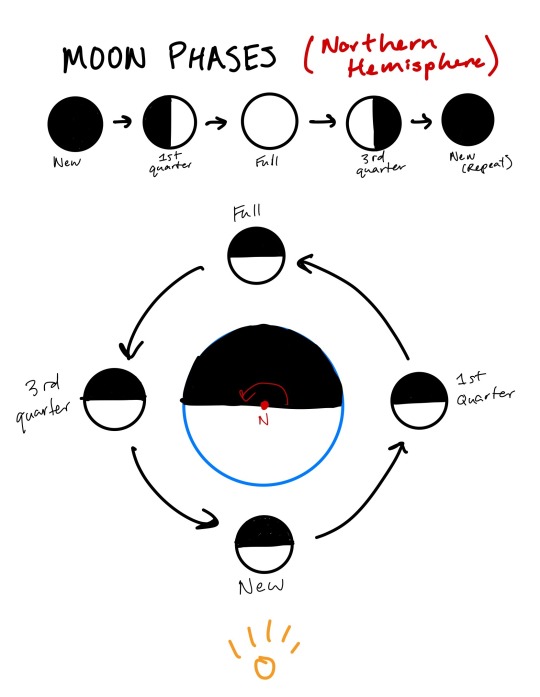
#stars has thoughts#space#the moon#amateur astronomy#thank you for coming to my ted talk#and thanks discord friends for saying 'write the moon infodump post!!'#when i was like 'i wonder if i should write a moon infodump post'#i am a humble space nerd slash backyard astronomer with a 4inch scope#but explaining how i visualize and remember space stuff in simple terms is one of my favorite things to do ever#i could do a bunch of other posts about stuff like this. why venus is the morning star. how telescopes work (explain it like i'm 5 edition)#perhaps i will#undescribed#(i will try to come back with image descriptions later but i have already done all the explaining of visual concepts with words#that i can manage today. apologies)
70 notes
·
View notes
Text
sevagoth prime you are so beautiful i'm glad to see you i cant wait for you to drop but where is my primed skeleton please ive been saving money for them blease
#warframe#sevagoth prime rocks he looks great#but im kind of sad they're skipping both xaku and lavos and we wont see them for 1-2 more cycles at least#will i finally learn how to play sevagoth in the meantime#perhaps i will
11 notes
·
View notes
Note
I’m here for my revenge 😈
Fuck marry kill: Jean, Erwin, Daichi 👀🤭
Oh man…you came out swinging, Dee.
Fuck: Jean. I mean, OF COURSE I would.
Marry: Daichi, without a doubt. The way that man wrangled high schoolers, you know he’d be the best husband and dad.
Kill: Erwin. Nothing personal, it’s just business. (I’m sure he’d understand.)
#hmmm should I send you more?#perhaps I will#as a little trick and treat this Halloween#lovely moots 💕#moots:Dee
5 notes
·
View notes
Text
mayhaps i shoukd post my lgbtqia+ hcs for sonic charactrrs... ?
2 notes
·
View notes
Text
something i find really interesting about the way i engage with fandoms and how my interests manifest i guess is the specific fixation on ships/characters that drive my obsession
like there are several things i enjoy that i would be mostly a casual fan of, if not for a character or a ship that immediately has all my love and attention
the main examples I can think of this are:
Eric Matthews, and Jeric
I adore BMW but if they weren't part of it, it would've definitely just been one of those shows I watch maybe once or twice and that's it, like Eric Matthews is one of if not my favourite character of all time and Jeric happens to be also one of my favourite ships ever as well like that drives 80% of the reason why I love BMW so much
Dylan Lenivy, and Rylan
Again, I love the Quarry, but Dylan is absolutely the reason why I love it so much and I'm also obsessed with Rylan! Rylan was one of those ships that absolutely got me, like I literally could not sleep because I loved them so much I had to spend every waking moment reading fics, watching compilations and playthroughs, and scrolling through tags like Rylan possessed me thoroughly and every now and then I'll fall back into that again. I wrote a couple fics for them (a little two part series) and I do have a multichap planned that I will probably get around to whenever my RTC obsession fades. They are 10000% the reason why I love the Quarry so much and Dylan as a character means so much to me I could rant about this forever.
Jetiana
Now this one is slightly different because I didn't immediately latch onto one character in particular, but both of them equally. Like I don't know how Jett and Ariana became two of my favourite characters, not only in TNS but literally ever, but watching S9 I immediately loved both of them, as a ship and as characters, and I think they're definitely responsible for taking my interest in TNS from something enjoy consistently but casually in my life to one of my favourite fandoms. Like I think I could only make edits of them for the rest of my life and be content with that 😭 They definitely reached the same level of obsession that I went through with Rylan and maybe even surpassed it, and I actually do have a multichap for them! I haven't updated it since I posted the first chapter but that's less because I've lost interest and more because writing TNS fics is so intimidating my writing style does not resemble or suit the TNS writing style in the slightest and that is so daunting 😭 But that's a conversation for another post lmao
I think those are the core three, there are definitely more instances of this and things that are similar but not quite, but these definitely incapsulate this phenomena lmao
#i could also talk about the opposite of this#like the fandoms that grasp me because of the full picture#like rtc and soy luna#perhaps i will#eric matthews#jeric#dylan lenivy#rylan#tns jett#tns ariana#jetiana
2 notes
·
View notes
Text
So is someone gonna write the Mark Beaks uses Huey to get to Fenton and therefore steal the gizmoduck suit. Perfect opportunity for whump, hurt comfort, and found family.
#someone pls write this#pls pls pls#perhaps i will#someday….#but not today#huey duck#huey dewey louie#gizmoduck#mark beaks#ducktales gizmo duck#fenton crackshell cabrera#dewey duck#boyd gearloose#BOYD#louie duck#donald duck#duckverse#whump#whump prompt#ducktales whump#whump ducktales
48 notes
·
View notes
Text
What if I made a pinned post……
3 notes
·
View notes
Note
Would you ever write for Leatin? Love your writing in other fandoms and they're my favorite ship
Well I'd never say never 😶 perhaps perhaps!!
@lucytara this you?
3 notes
·
View notes